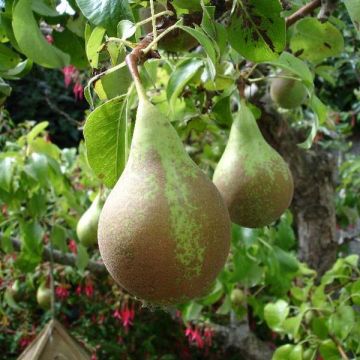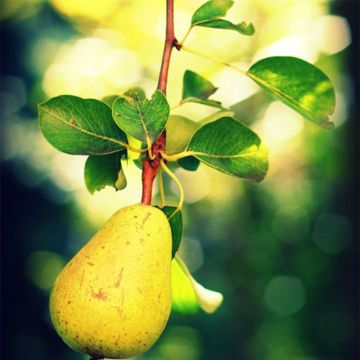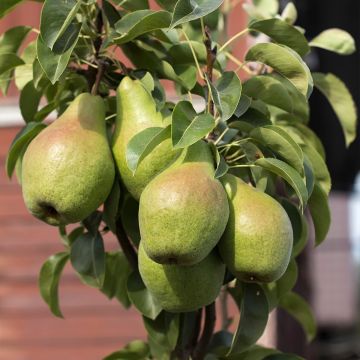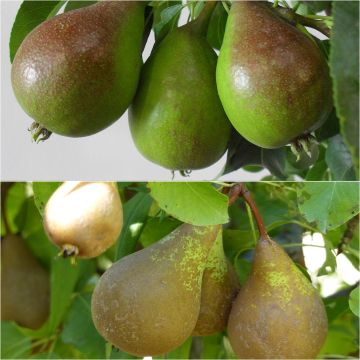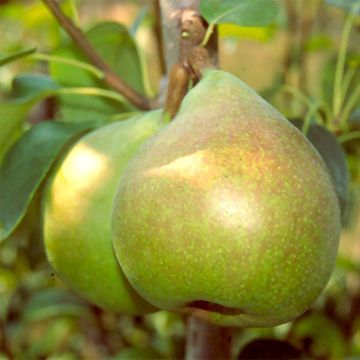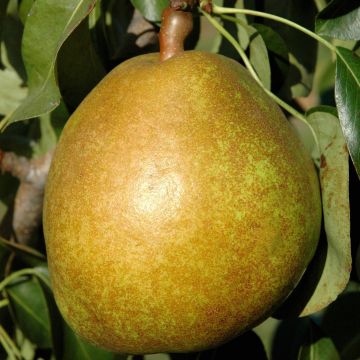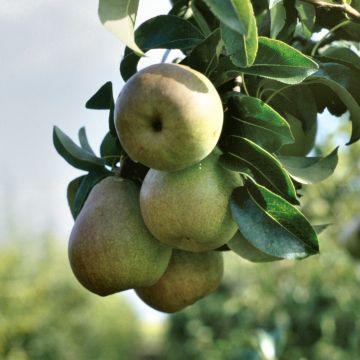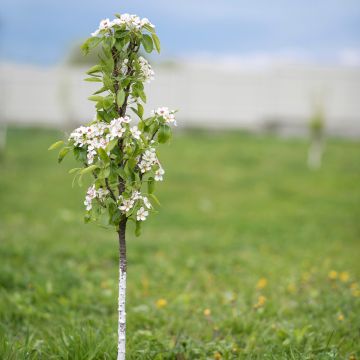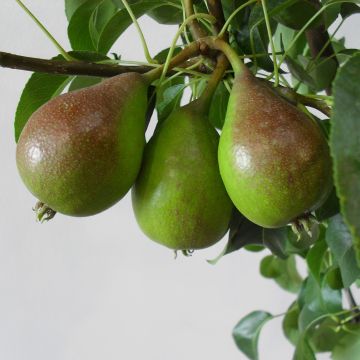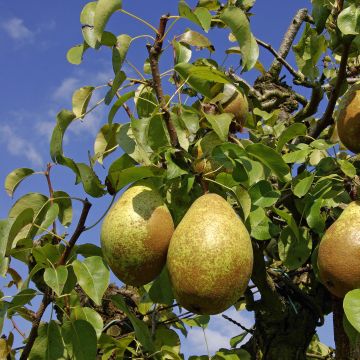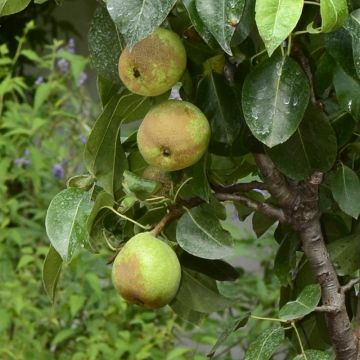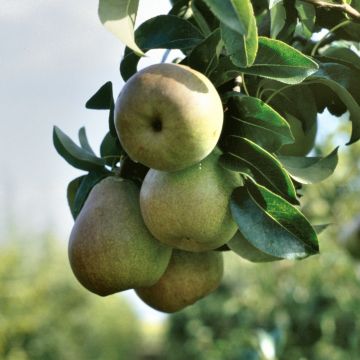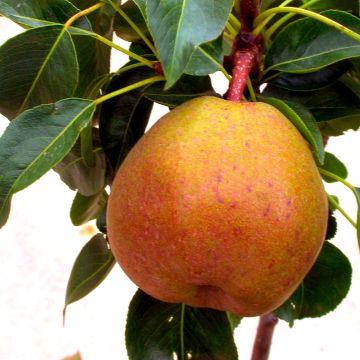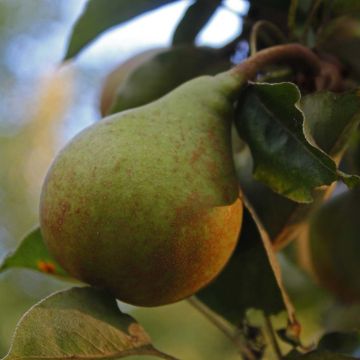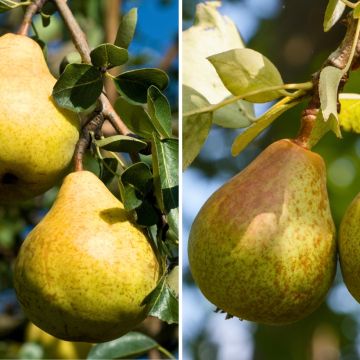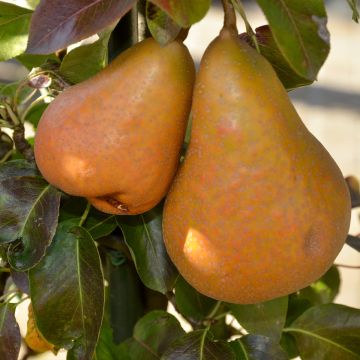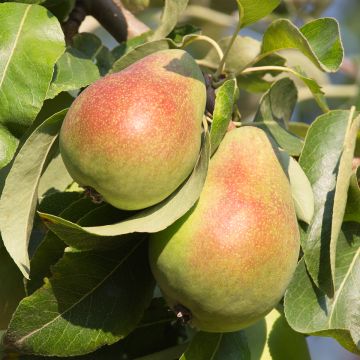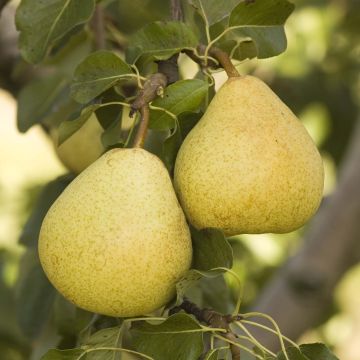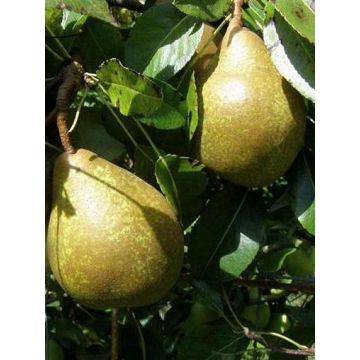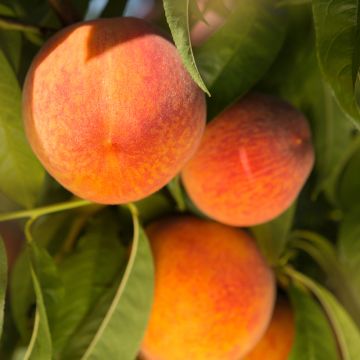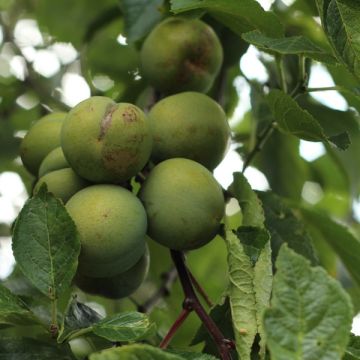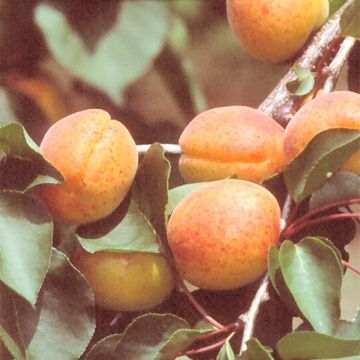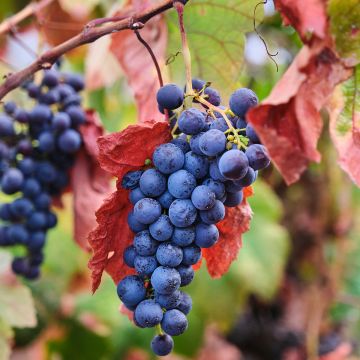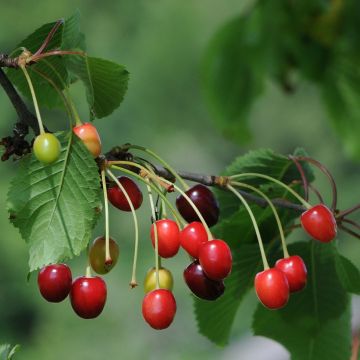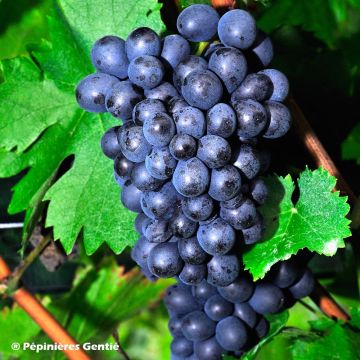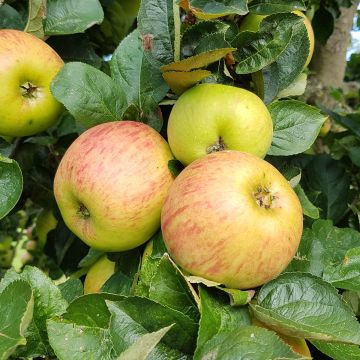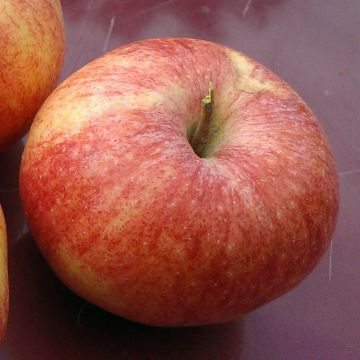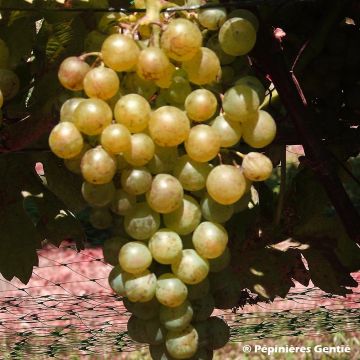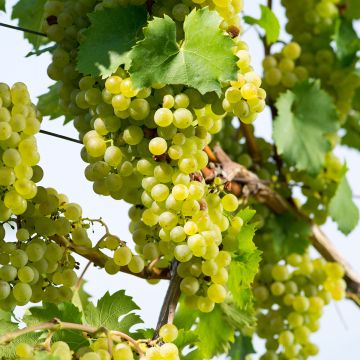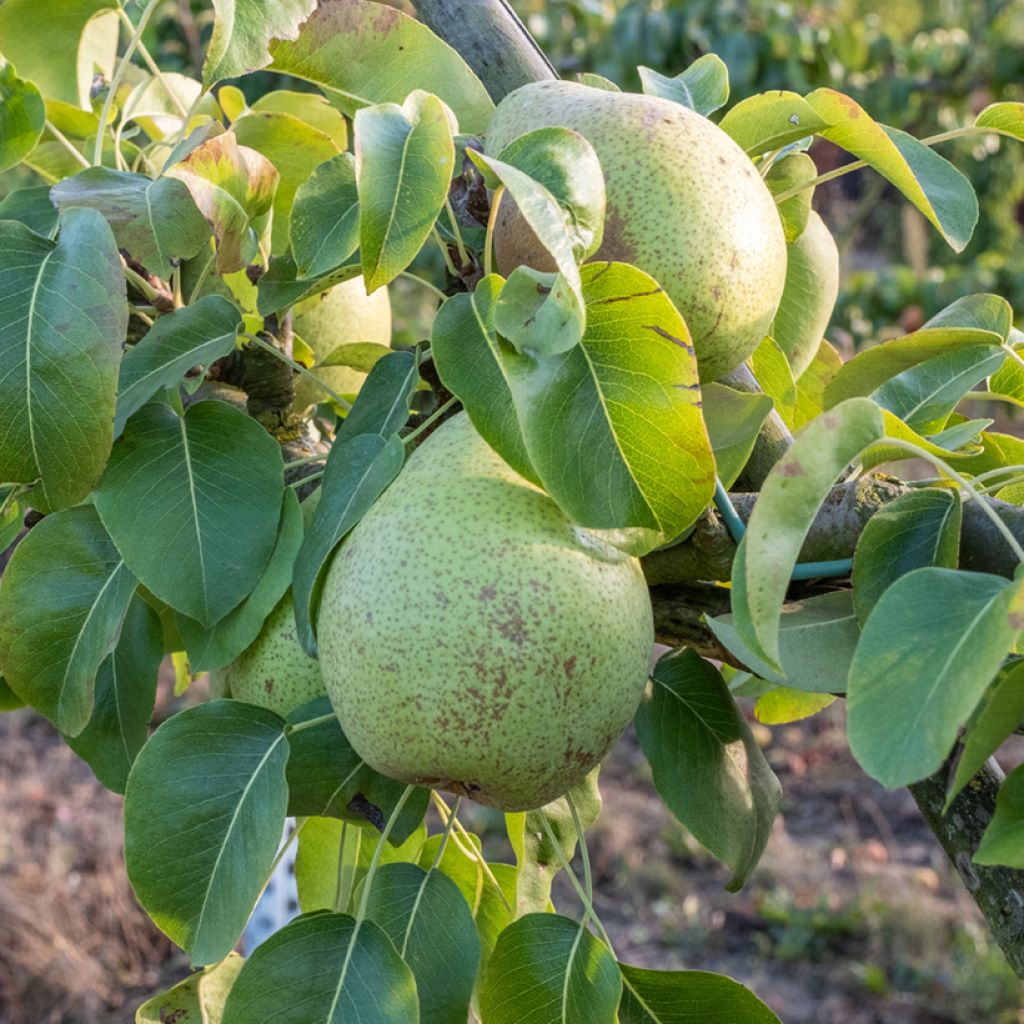

Pyrus communis Grise Bonne - Pear Tree
Pyrus communis Grise Bonne - Pear Tree
Pyrus communis Grise Bonne
European pear, Common pear
Why not try an alternative variety in stock?
View all →This plant carries a 6 months recovery warranty
More information
We guarantee the quality of our plants for a full growing cycle, and will replace at our expense any plant that fails to recover under normal climatic and planting conditions.
Oversize package: home delivery by special carrier from €6.90 per order..
Express home delivery from €8.90.
Delivery to Corse prohibited: UE law prohibits the import of this plant from mainland France to Corse as part of the fight against Xylella fastidiosa. Please accept our sincere apologies.
More information
Description
The Pear Tree 'Grise Bonne' or 'Dobra Szara' (Pyrus communis 'Bon Gris') is a very old variety of pear tree originating from France. This fruit tree produces small conical pears with a greenish-yellow skin sprinkled with brown freckles. Their flesh is juicy, sweet, tangy, with a unique spicy aftertaste. They are harvested from late August, every other year. This pear tree is also valued for its longevity, great hardiness, and resistance to scab. It is a partially self-fertile variety that requires the presence of other pear tree varieties nearby to enhance pollination and increase fruit yield.
Pyrus communis 'Grise Bonne' or 'Dobra Szara' is also known as 'Gute Graue', 'Graue', 'Sommerblutterbirne', 'Graapaere' in various countries. The wild species Pyrus communis (Common Pear) is a deciduous tree belonging to the Rosaceae family. Present in Europe since antiquity, it originates from the forests of Western Asia. Over the centuries, a vast number of cultivars have emerged. Its cultivation is widespread in Europe.
The 'Grise Bonne' Pear Tree is a fruit tree with a conical habit, a high and wide crown and vigorous growth, reaching a height of 6 to 8 m and a width of 4 to 6 m. It is a variety originating from France, cultivated since 1675. From there, the trees and fruits arrived in Germany under the name 'Beurre gris' as early as the 18th century. This summer pear is also known in Germany by other names such as 'Grey Pear', 'Grey Summer Butter Pear', 'Grisbirne', 'Summer Ambrette', or 'Schöne Gabriele'. Its massive flowering starts in April. The flowers are arranged in corymbs, each measuring between 2 and 3 cm wide. These flowers, although slightly frost-sensitive due to their earliness, lead to the formation of small conical fruits.
The pears of 'Grise Bonne' have a greenish-yellow skin almost entirely covered with brown and rough freckles. Their yellowish-white or dull white flesh is creamy, juicy, and tasty, with a granular texture at the core. They have a sweet-tangy taste with a spicy aftertaste and hints of cinnamon. The fruit harvesting period starts from late August, and they are ready to be consumed from mid-September. The fruits are characterised by a small to medium size, an ovoid to elliptical shape, with a base colour ranging from green to greenish-yellow, turning cinnamon brown when ripe.
The foliage of this 'Grise Bonne' pear tree is shiny green in summer and turns orange-yellow in autumn, adding a touch of colour to the garden. The bark is smooth and greyish, slightly cracking with age. The 'Grise Bonne' pear tree lives for many years, is robust, and adapts to most garden soils, although it prefers sandy-loamy soil. It can be grown in mountainous areas up to an altitude of 700 metres.
This Pear Tree is said to be self-sterile or self-incompatible, as the flowers cannot self-pollinate. Hence, the presence of other pear tree varieties nearby, flowering at the same time, is necessary. For example, varieties like 'Louise Bonne d'Avranches', 'Clapp's Favorite', and 'Beurré Hardy' are suitable for cross-pollination, thereby increasing fruit yield.
The 'Grise Bonne' pear tree is a variety that produces every two years. The fruits can be consumed raw or cooked, in compotes, pastries, desserts, fruit salads, paired with cheeses, or as an accompaniment to savoury dishes, alongside duck, white meats (poultry and lamb), or game. The pear is also perfect for making juices or fruit syrups. Rich in water, pears refresh and quench thirst. They are very fleshy and satisfying. Moderately calorific, they are rich in potassium, calcium, and magnesium, with a significant iron content. Their content of vitamins C and E, antioxidants, and fibres make pears a healthy choice. They are invigorating, energising, and rehydrating. Storage can be done in a cool, clean place, away from light at a temperature around 8 to 10°C, or in a cold room, sealed from external air at a temperature of 1 to 3°C.
This fruit tree prefers deep soils and dislikes poor, overly draining, dry, and calcareous soils. To obtain high-quality fruits, thin to reduce the number of fruits on the tree. Aeration pruning, by removing some branches in the centre of the tree, will provide light and give a beautiful colour to the fruits. This will also limit disease. Very popular for its fruits, the pear tree finds a place in the garden for the enjoyment of both young and old. With a wide range of pear trees, it is easy to find the one that best suits your desires.
Report an error about the product description
Plant habit
Fruit
Flowering
Foliage
Safety measures
Botanical data
Pyrus
communis
Grise Bonne
Rosaceae
European pear, Common pear
Pyrus communis Gute Graue, Graue Sommerblutterbirne, Graapaere, Dobra Szara
Cultivar or hybrid
Phytophotodermatoses
Cette plante peut provoquer l'apparition de réactions cutanées indésirables en cas de contact suivi d'une exposition au soleil.
Ne la plantez pas là où de jeunes enfants peuvent évoluer. Evitez l'exposition au soleil après l'avoir manipulée. Evitez tout contact avec la peau: privilégiez l'emploi de gants pour la manipuler. En cas de contact, lavez-vous soigneusement les mains et rincez abondamment à l'eau la zone concernée. Lavez les vêtements entrés en contact. En cas de réaction cutanée, contactez votre médecin ou le centre antipoison le plus proche de chez vous. En cas d'atteinte étendue, appelez sans tarder le 15 ou le 112.Pensez à conserver l'étiquette de la plante, à la photographier ou à noter son nom, afin de faciliter le travail des professionnels de santé.
Davantage d'informations sur https://plantes-risque.info
Other Pear trees
Planting and care
The pear tree 'Grise Bonne' thrives in moist, rich soils without stagnant moisture, but does not appreciate shallow, too dry, or too calcareous soils. Pear trees, like all fruit trees, are best planted between October and March, excluding frost periods. Trees offered in containers can be planted all year round except during periods of high heat or frost.
To plant, loosen the soil deeply and remove rocks and weeds. Add some gravel to improve drainage if necessary. Dig a wide planting hole at least 3 times the volume of the root ball. Make sure to set aside the subsoil and the topsoil separately. Mix crushed horn and organic matter (potting soil, compost, etc.) with the subsoil and pour this mixture into the planting hole. Place the root ball, cover with the topsoil without burying the graft union and tamp down. Water generously (around 10 litres). It may be beneficial to stake the pear tree by installing a guy wire system: plant 3 stakes in a triangle 50 cm around the trunk and connect them with pieces of wood. Protect the bark with a piece of rubber, for example, and tie the stakes to the trunk with metal wire. It is also possible to train it on a support (e.g., U-shaped espalier or Verrier espalier).
For maintenance, every autumn, apply well-rotted compost on the surface. Then, in winter, add a small shovelful of wood ash, rich in potash, to improve fruiting. Hoe if necessary at the base of the tree. Water regularly, depending on your climate, during the first two or three years.
The pear tree can be susceptible to various diseases and pests. Against scab (brown spots on leaves), blossom blight (drying of flowers and fruit rot on the tree), and powdery mildew (white fuzz on leaves), spray preventively with Bordeaux mixture and horsetail decoctions. As for pests, the codling moth or fruit worm, a small caterpillar, can be countered by installing bird and bat boxes, placing corrugated cardboard strips along the trunk, and bagging fruits in brown kraft paper. In case of aphid infestation, spray a mixture of water and black soap.
Planting period
Intended location
Care
This item has not been reviewed yet - be the first to leave a review about it.
Ancient and local varieties
Haven't found what you were looking for?
Hardiness is the lowest winter temperature a plant can endure without suffering serious damage or even dying. However, hardiness is affected by location (a sheltered area, such as a patio), protection (winter cover) and soil type (hardiness is improved by well-drained soil).

Photo Sharing Terms & Conditions
In order to encourage gardeners to interact and share their experiences, Promesse de fleurs offers various media enabling content to be uploaded onto its Site - in particular via the ‘Photo sharing’ module.
The User agrees to refrain from:
- Posting any content that is illegal, prejudicial, insulting, racist, inciteful to hatred, revisionist, contrary to public decency, that infringes on privacy or on the privacy rights of third parties, in particular the publicity rights of persons and goods, intellectual property rights, or the right to privacy.
- Submitting content on behalf of a third party;
- Impersonate the identity of a third party and/or publish any personal information about a third party;
In general, the User undertakes to refrain from any unethical behaviour.
All Content (in particular text, comments, files, images, photos, videos, creative works, etc.), which may be subject to property or intellectual property rights, image or other private rights, shall remain the property of the User, subject to the limited rights granted by the terms of the licence granted by Promesse de fleurs as stated below. Users are at liberty to publish or not to publish such Content on the Site, notably via the ‘Photo Sharing’ facility, and accept that this Content shall be made public and freely accessible, notably on the Internet.
Users further acknowledge, undertake to have ,and guarantee that they hold all necessary rights and permissions to publish such material on the Site, in particular with regard to the legislation in force pertaining to any privacy, property, intellectual property, image, or contractual rights, or rights of any other nature. By publishing such Content on the Site, Users acknowledge accepting full liability as publishers of the Content within the meaning of the law, and grant Promesse de fleurs, free of charge, an inclusive, worldwide licence for the said Content for the entire duration of its publication, including all reproduction, representation, up/downloading, displaying, performing, transmission, and storage rights.
Users also grant permission for their name to be linked to the Content and accept that this link may not always be made available.
By engaging in posting material, Users consent to their Content becoming automatically accessible on the Internet, in particular on other sites and/or blogs and/or web pages of the Promesse de fleurs site, including in particular social pages and the Promesse de fleurs catalogue.
Users may secure the removal of entrusted content free of charge by issuing a simple request via our contact form.
The flowering period indicated on our website applies to countries and regions located in USDA zone 8 (France, the United Kingdom, Ireland, the Netherlands, etc.)
It will vary according to where you live:
- In zones 9 to 10 (Italy, Spain, Greece, etc.), flowering will occur about 2 to 4 weeks earlier.
- In zones 6 to 7 (Germany, Poland, Slovenia, and lower mountainous regions), flowering will be delayed by 2 to 3 weeks.
- In zone 5 (Central Europe, Scandinavia), blooming will be delayed by 3 to 5 weeks.
In temperate climates, pruning of spring-flowering shrubs (forsythia, spireas, etc.) should be done just after flowering.
Pruning of summer-flowering shrubs (Indian Lilac, Perovskia, etc.) can be done in winter or spring.
In cold regions as well as with frost-sensitive plants, avoid pruning too early when severe frosts may still occur.
The planting period indicated on our website applies to countries and regions located in USDA zone 8 (France, United Kingdom, Ireland, Netherlands).
It will vary according to where you live:
- In Mediterranean zones (Marseille, Madrid, Milan, etc.), autumn and winter are the best planting periods.
- In continental zones (Strasbourg, Munich, Vienna, etc.), delay planting by 2 to 3 weeks in spring and bring it forward by 2 to 4 weeks in autumn.
- In mountainous regions (the Alps, Pyrenees, Carpathians, etc.), it is best to plant in late spring (May-June) or late summer (August-September).
The harvesting period indicated on our website applies to countries and regions in USDA zone 8 (France, England, Ireland, the Netherlands).
In colder areas (Scandinavia, Poland, Austria...) fruit and vegetable harvests are likely to be delayed by 3-4 weeks.
In warmer areas (Italy, Spain, Greece, etc.), harvesting will probably take place earlier, depending on weather conditions.
The sowing periods indicated on our website apply to countries and regions within USDA Zone 8 (France, UK, Ireland, Netherlands).
In colder areas (Scandinavia, Poland, Austria...), delay any outdoor sowing by 3-4 weeks, or sow under glass.
In warmer climes (Italy, Spain, Greece, etc.), bring outdoor sowing forward by a few weeks.

































